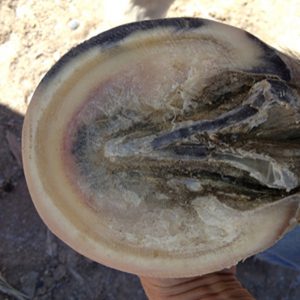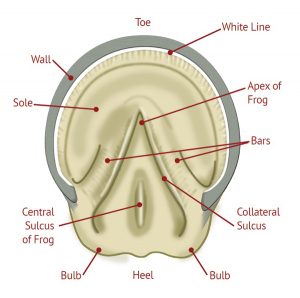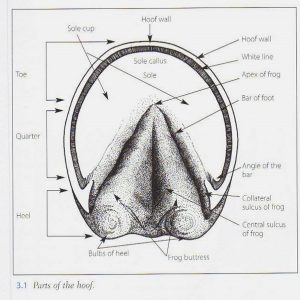The White Line
By Brian S. Burks, DVM
Diplomate, ABVP
Board-Certified Equine Specialist
A hoof is layered from the outside in (hoof wall, hoof horn, laminae). The hoof wall supports the majority of the horse’s weight rather than the sole of the foot. The hoof wall is similar to your finger nail in that it is made of dead cells that are unable to heal; they must be regrown when damaged.
Beneath the hoof wall is the hoof horn, which is attached to the laminae, which are attached to the third phalanx (P3 or coffin bone). At the top of the hoof is the coronary band, the source of nutrition for the hoof wall, which is similar to the cuticle of your fingernail.
 The primary epidermal lamellae project from the inner surface of the hoof wall, and each has 100-200 secondary epidermal lamella. The insensitive horn of these epidermal lamellae interdigitates with the sensitive dermal lamellae to furn the functional connection between the hoof wall and the third phalanx. The horn that forms the epidermal lamellae is unstructured or non-tubular. As the hoof wall grows, it moves distally by a mechanism that allows the primary epidermal lamellae to slide past the stationary secondary epidermal lamellae. On the sole, the white line is the junction between the sensitive and insensitive laminae and is the distal projection of the terminal epidermal and dermal laminae. When the horse is shod, nails should be at the periphery of the white line.
The primary epidermal lamellae project from the inner surface of the hoof wall, and each has 100-200 secondary epidermal lamella. The insensitive horn of these epidermal lamellae interdigitates with the sensitive dermal lamellae to furn the functional connection between the hoof wall and the third phalanx. The horn that forms the epidermal lamellae is unstructured or non-tubular. As the hoof wall grows, it moves distally by a mechanism that allows the primary epidermal lamellae to slide past the stationary secondary epidermal lamellae. On the sole, the white line is the junction between the sensitive and insensitive laminae and is the distal projection of the terminal epidermal and dermal laminae. When the horse is shod, nails should be at the periphery of the white line.
The white line is a yellowish line near the white inner wall of the hoof. This causes misinterpretation of the white line as the inner wall, so the it is sometimes called the Golden Line, a more accurate description used in the 1800s. Its purpose is to join the sole to the inner hoof wall and seal off the border of the coffin bone to protect the inner hoof from bacterial infiltration. It creates a shallow crease at the bottom of the hoof which fills with dirt, aiding with traction.
In normal, healthy horses, the white line should be only a few millimeters wide. When the laminae are damaged, there is stretching of the tissues, widening the white line. This may require cleaning and light trimming of the dried sole to see this wide white line.
A wide white line indicates rotation or movement of the third phalanx within the hoof and is associated with chronic laminitis. It is sometimes see in horses with club foot. This white line can become pitted and porous, allowing infection to thrive, predisposing to abscess formation.
Fox Run Equine Center
(724) 727-3481
Experienced. Dedicated. Focused on the Horse.












